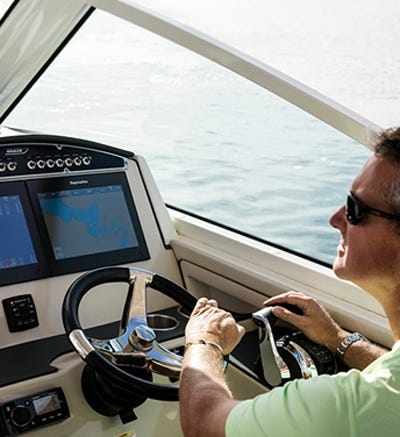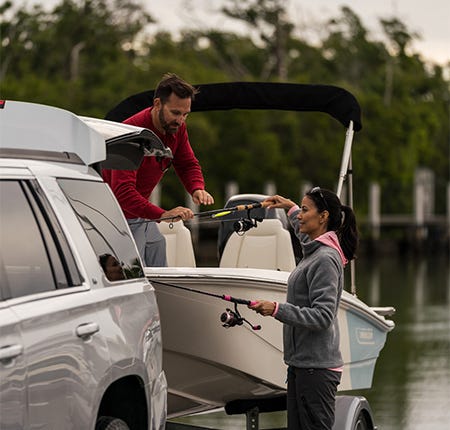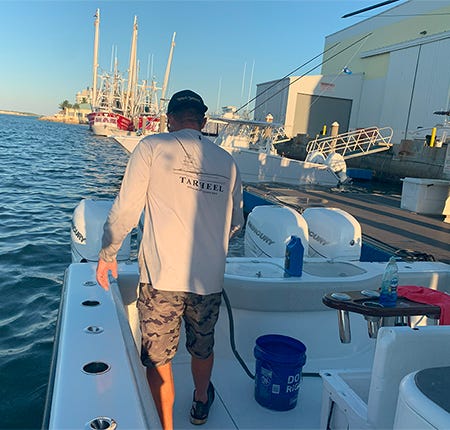

If you’ve been boating long enough, you’ve probably experienced the nightmare boating scenario. It’s 5:30 a.m. and there’s an unusually long line of boats at the ramp waiting to drop in. Pretty quickly, you realize that nobody is moving. After a few minutes, you get out of your truck to see what’s going on, and there’s a truck on the ramp with a swarm of people all over it. You quickly learn what’s happened. The boater tried to launch, but the outboard wouldn’t start. Frustrated, the owner went back to the truck to get a few things and accidentally locked his keys inside. To make matters worse, the boat is filling up with water because the plug wasn’t put in. There’s one ramp, and a lot of days ruined.
They say that trouble comes in threes, and there is some truth to that. One mistake can get you flustered enough to make more mistakes, starting a cycle of misery that quickly goes from comical to catastrophic. In many cases, avoiding that first mistake stops the cycle before it begins. When it comes to boating, there are some easy ways to ensure that every trip goes smoothly. Consider these pro tips to keep your days on the water enjoyable.
Contents
- 1. Consistent Input = Consistent Outcome
- 2. Start Your Pre-Trip Routine the Day Before You Go
- 3. Day of Trip Routine
- 3.1 Final Equipment Loading:
- 3.2 Trailer Re-Check:
- 3.3 Power On, Plugs In:
- 3.4 Windows Open When Launching:
- 4. Dock or Ramp Return Routine
- 4.1 Motor Up:
- 4.2 Electronics Off and Unplugged:
- 4.3 Keys/Remotes Stowed:
- 4.4 Equipment gathered:
- 4.5 Tie-Downs:
- 4.6 Power Off:
- 4.7 Wipe Down:
- 4.8 Trailer inspection:
- 5. Post Trip Routines
- 5.1 Clean up/wash down:
- 5.2 Power off/Batteries Charged:
- 5.3 Leave it Like you Want To Find it:
- 6. Expect the Unexpected
- 6.1 Critical Spares:
- 6.2 Tools and Equipment:
- 6.3 First Aid Kit:
Consistent Input = Consistent Outcome
Ask any veteran boater what they do to avoid unexpected issues, and the first thing they will talk about is their routines. Almost every seasoned boater has a strict set of procedures that they go through before, during and after each trip.
Many complete these routines in the same exact order each time, and they will re-start the process from the beginning if they get interrupted.
It may seem counterintuitive that the most experienced boaters keep mental and written checklists, but these veterans have learned the hard way not to trust their memory. For many boaters, these routines add to the enjoyment of their trips. Pre-trip routines build anticipation, and the post-trip routines provide a cathartic wind-down at the end of the day.
For many boaters, these routines add to the enjoyment of their trips.
Start Your Pre-Trip Routine the Day Before You Go
Most experienced boaters start their routines the day before the trip. Not only does this give them more time to think through their preparations, it also gives them time to identify and react to unexpected issues common to boating. An engine issue or depleted battery is never a pleasant discovery, but these kinds of problems can often be addressed if they’re identified the day before. Discovering a dead cranking battery after you have the trailer backed in is a different store. Establish a routine for the day prior to your trip that includes:
- Engine pre-start: Start the engine(s) before your trip to ensure there are no issues, particularly if the boat has been sitting for a while.
- Battery check: Check voltage and charge batteries, regardless of whether they were previously charged.
- Trailer inspection: Check tire pressure, bearing grease, brake lights, coupler, chains, straps, and tie-downs.
- Gas and oil check: Fuel the boat and check engine oil to make sure you are ready for the journey.
- Main power “Off” verification: Before heading off to bed, double-check that the main power switch is in the “off” position. A single courtesy light left on can drain a battery overnight, ruining your plans for the next day.
- Critical boat items: Have a waterproof box that contains your boat keys, remotes, plugs, license and registration in one place. Keep this on the boat if you can.
- Equipment staging: Gather your equipment the day before and either load it in your vehicle or put it in a staging location. This is also a good time to re-check safety equipment to ensure you are compliant with local boating regulations. For anything you can’t load the night before (food, drinks, etc), make a list of and put it on your vehicle’s steering wheel.
Day of Trip Routine
If you’ve established a solid pre-trip routine, your “morning of” routine becomes much simpler, a particularly good thing if you take early morning trips. Before heading to the ramp, dock or marina, your routine is primarily a function of loading last-minute items and double checking the most critical items from the day before. Common elements of this routine include:
1. Final equipment loading:
Load those last-minute items that couldn’t be loaded the day before, such as food, ice, drinks, and equipment that you weren’t comfortable leaving unsecured overnight.
2. Trailer re-check:
Re-inspect the coupler, chains, and lights. Also, check that your outboard is properly positioned and secured for travel.
3. Power on, plugs in:
These two items should be the last thing checked before you leave for the ramp and the first thing checked when you get to the ramp.
4. Windows open when launching:
It’s a great practice to have your vehicle windows rolled down whenever you are backing up your trailer. This will give you the maximum amount of reaction time if something goes wrong. The last thing you ever want to experience when backing up with a trailer is an unexpected jarring impact.
Dock or Ramp Return Routine
Whether you leave your boat at a marina or dock, or reload it on your trailer at a ramp, there are routines that should happen immediately after a trip. These include:
Motor up:
Make it a habit to raise your engine immediately upon loading your boat on the trailer to keep your skeg and prop out of harm’s way.
Electronics off and unplugged:
The minute your motor is up, make sure that all of your electronics are off, including radios, chart plotters and trolling motors. If these can be easily unplugged from their power source, do so, as some of these electronics can be damaged when charging batteries.
Keys/remotes stowed:
Immediately stow these in their proper location before you get off the boat, and never put them in your pocket. Having a dedicated compartment or container for these critical items is a great way to avoid misplacing them between trips. If possible, keep these in your console or somewhere on the boat so they are where you need them.
Equipment gathered:
Before your feet ever hit solid ground, take a moment to gather up all of your equipment and put it in one place on the boat that is accessible from either the ground (if trailering) or the dock. This makes unloading extremely efficient and minimizes dirt and footprints caused by constantly exiting and re-boarding your boat.
Tie-downs:
Keep your tie-down straps on your front seat when you launch. This will help you avoid forgetting to tie down your boat on your return trip.
Power off:
Turn off your main power switch before you trailer your boat (or leave it at the dock). Doing this before getting on the road eliminates the risk of running down batteries or having equipment, such as power poles, deploy unexpectedly.
Wipe down:
Take a moment to wipe off the scum line of your boat while the hull is still wet. That same scum line that wipes away easily when wet will require some serious scrubbing if allowed to dry.
Trailer inspection:
No matter how well you checked your trailer before your trip, take a moment and check it again before you leave the ramp. Most of the time, it will look exactly like you left it, but eventually, you’ll find something unexpected — a tail light someone hit, a deflated tire, or an unlocked coupler that somehow missed your attention the first time. A 30-second inspection can eliminate the chance of something going catastrophically wrong.
Post Trip Routines
Veteran boaters have post-trip routines that are as disciplined and rigorous as their pre-trip routines, and the most successful boaters are uncompromising on completing these routines immediately after each trip, no matter how hot, tired or rushed they feel. Just as the pre-trip routines can add to the anticipation before a trip, post-trip routines are a great way to wind down and extend the trip experience before returning to normal life. The items below will both help maintain your boat and equipment and make your next pre-trip routine easier:
Clean up/wash down:
Regardless of whether you boat in saltwater or freshwater, taking the time to clean your boat after each trip will lengthen its lifespan and improve its value. Having the right boat-specific cleaning products on hand is helpful. Have a garbage bag handy to clean out hatches and remove trash before you trailer home, and flush your engine as quickly as possible to minimize salt buildup in your engine.
Power off/batteries charged:
Many electronics manufacturers recommend that you disconnect devices from their power source before charging your batteries, and this is especially true for trolling motors. Once your power is off, immediately recharge your batteries after each trip. This will extend the life of your batteries and ensure you are ready to go for the next trip.
Leave it like you want to find it:
Every boater uses their boats differently, but each boater should have a “default” condition for their boat that eliminates variability in their routines. When you store your boat, return it to the exact same condition each time — this means having the same equipment on the boat and the same equipment off the boat after each trip. When you start your pre-trip routines, you are always starting from the same point.
Regardless of how long you have been boating, establishing strong, consistent routines will improve your overall experience. Not only will these routines make your day on the water more enjoyable, your pre-trip routines will add to the anticipation of the adventure to come, and your post-trip routines will help you wind down and relax knowing that your boat is ready for its next adventure. Take your boating to the next level by putting these routines in place for your next trip.
Expect the Unexpected
Even with the most disciplined routines, things will go wrong. The good news is that these “unexpected” issues are relatively predictable, and with a little planning, you can minimize their impact. Consider the most common things that can go wrong on your boat, and build redundancies into your preparations:
Critical Spares:
Keep the following spare items in a waterproof container in a dry storage compartment on your boat:
-
- Spare boat key
- Extra fuses for each size fuse your boat uses
- Extra drain plugs — and keep one in your primary tow vehicle as well!
- Spare remote batteries — keep a set of spare batteries for each of your remotes
Tools and equipment:
Having the right tools on hand will give you the ability to deal with the unexpected:
-
- Jumper cables or mini battery jumper
- Basic tool set — including wrenches, pliers, screwdrivers electrical tape
- Spare wheel assembly — including an extra hub, packed bearings and grease, and even a spare tire for longer trips
First aid kit:
Be ready to address minor medical issues with a first aid kit that includes:
-
- Bandages
- Gauze/medical tape
- Pain relievers
- Allergy medication
- Alcohol wipes/disinfectant



